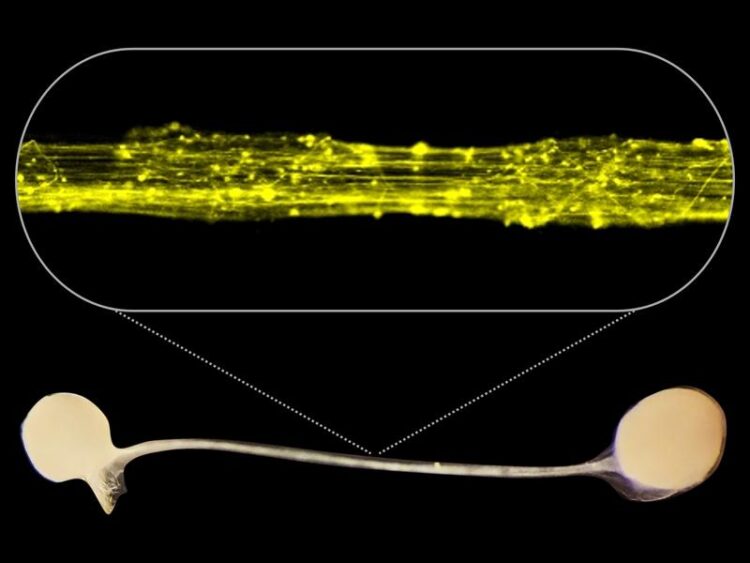First model of the brain’s information highways developed

Microscopic image of long-range axons connecting two brain organoids. Magnification shows fluorescence labeling of single axons.
(c) Catarina Martins-Costa/IMBA
Our human brain is not only bigger and contains more neurons than the brains of other species, but it is also connected in a special pattern: Thick bundles of neurons connect brain regions across long distances, such as the right and left brain hemispheres. A team of researchers at IMBA, including Catarina Martins-Costa, Nina Corsini and Jürgen Knoblich, now presents the first organoid model in which these information highways can be studied. Their results are published on May 7th in the journal Cell Stem Cell.
Our brain resembles the road network: like country roads, small connections link neighboring nerve cells, while, like highways, thick nerve bundles connect different regions of the brain. These thick, heavily used nerve bundles, which for example connect the left and right brain hemispheres or the brain’s front and back, could not be investigated experimentally so far. The research team led by Jürgen Knoblich at the Institute of Molecular Biotechnology (IMBA) of the Austrian Academy of Sciences, collaborating with Gregor Kasprian and colleagues at the Medical University Vienna, now succeeded in developing an organoid model of these nerve bundles.
To model the long-range, heavily used nerve bundles, the research team made use of knowledge about a rare neurodevelopmental disorder, in which the connection between left and right brain hemispheres does not develop. The corpus callosum, the bridge between left and right in our brain, is a particularly heavily used information highway. However, in very rare cases, this connection does not form during development. This can be detected before birth, as part of the ultrasound screening around the 18th pregnancy week. “In such cases, fetal magnetic resonance imaging (MRI) can be used to obtain a precise image of the fetal brain as well as the missing corpus callosum and associated structural irregularities,” says neuroradiologist and co-author Gregor Kasprian.
In about ten percent of cases, mutations in a gene called ARID1B are responsible for this defect. “Clinically, it has been well described that mutations in ARID1B are associated with a lack of the corpus callosum. Until now, however, nothing was known about the molecular mechanisms that play a role in this defect”, Catarina Martins-Costa, the study’s first author, explains.
Using blood cells from two patients with ARID1B mutations as the starting material, the researchers produced stem cells, from which they in turn developed three-dimensional brain organoids. Uniquely, these brain organoids also carry the mutation in the ARID1B gene. This enabled the researchers to study how this mutation affects the development of long-range nerve projections – a model for the brain’s highways.
“Organoids allow us to trace all steps in neuronal development and investigate them directly in human tissues”, Jürgen Knoblich explains. To model the connection between two brain hemispheres, the research team collaborated with Yoshiho Ikeuchi at the University of Tokyo. They placed two brain organoids into a 3D-printed mold, in which the organoids were connected by a microchannel. The researchers observed how the two organoids connected through their neuronal projections, also called axons. Indeed, the ARID1B mutations greatly affected connectivity. “Healthy organoids develop an organized axon bundle with many axons that connect with the other organoid. Organoids containing the ARID1B-mutation also develop these bundles, however, the number of connecting axons is far smaller”, Nina Corsini, the study’s co-corresponding author, described.
Further investigation showed that gene expression is changed in ARID1B-mutated neurons, Martins-Costa adds. “We saw that groups of genes responsible for neuronal maturation and axon generation were less expressed, which explains why mutant callosal neurons are not able to produce long-range axons for the corpus callosum.”
Brain organoids containing an ARID1B mutation are therefore the first model with which these important neuronal connections of the human brain can be studied in detail. This development is highly relevant also for clinical research, Knoblich emphasizes. “Our system provides an innovative technology, that can now be used to test gene therapies for patients with ARID1B mutations. In fact, we already work with the patient organization ‘The Foundation for ARID1B Research’ to test a gene therapy before it will enter the clinic.”
Jürgen Knoblich is also Professor of Synthetic Biology at the Medical University of Vienna.
Wissenschaftliche Ansprechpartner:
Sylvia Weinzettl
IMBA – Institute of Molecular Biotechnology GmbH
Dr. Bohr-Gasse 3, 1030 Vienna
T: +43 1 79044 – 4403
Mail: sylvia.weinzettl@imba.oeaw.ac.at
www.imba.oeaw.ac.at
Originalpublikation:
Catarina Martins-Costa, Andrea Wiegers, Vincent A. Phan, Jaydeep Sidhaye, Balint Doleschall, Maria Novatchkova, Thomas Lendl, Marielle Piber, Angela Peer, Paul Möseneder, Marlene Stuempflen, Siu Yu A. Chow, Rainer Seidl, Daniela Prayer, Romana Höftberger, Gregor Kasprian, Yoshiko Ikeuchi, Nina S. Corsini, Jürgen A. Knoblich. ARID1B controls transcriptional programs of axon projection in an organoid model of the human corpus callosum. Cell Stem Cell 10.1016/j.stem.2024.04.014
Weitere Informationen:
https://www.oeaw.ac.at/imba/research-highlights/news/first-model-of-the-brains-i…
Media Contact
All latest news from the category: Life Sciences and Chemistry
Articles and reports from the Life Sciences and chemistry area deal with applied and basic research into modern biology, chemistry and human medicine.
Valuable information can be found on a range of life sciences fields including bacteriology, biochemistry, bionics, bioinformatics, biophysics, biotechnology, genetics, geobotany, human biology, marine biology, microbiology, molecular biology, cellular biology, zoology, bioinorganic chemistry, microchemistry and environmental chemistry.
Newest articles

NASA: Mystery of life’s handedness deepens
The mystery of why life uses molecules with specific orientations has deepened with a NASA-funded discovery that RNA — a key molecule thought to have potentially held the instructions for…

What are the effects of historic lithium mining on water quality?
Study reveals low levels of common contaminants but high levels of other elements in waters associated with an abandoned lithium mine. Lithium ore and mining waste from a historic lithium…

Quantum-inspired design boosts efficiency of heat-to-electricity conversion
Rice engineers take unconventional route to improving thermophotovoltaic systems. Researchers at Rice University have found a new way to improve a key element of thermophotovoltaic (TPV) systems, which convert heat…



